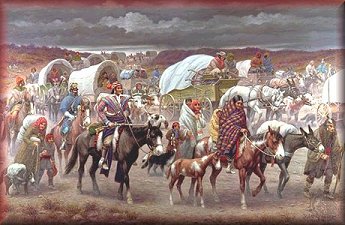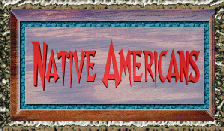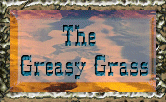

"Trail
of Tears"



The Cherokee Nation - largest of the Five Civilized Tribes of the Southeast - is a people of Iroquoian lineage.
The
Cherokee, who called themselves 'Ani'-Yun' wiya' - 'Principal People' -
the 'Keetoowah' - 'people of Kituhwa' - or Tsalagi from their own name
for the Cherokee Nation - migrated to
the
Southeast from the Great Lakes Region.
They
commanded more than 40,000 square miles
in
the southern Appalachians by 1650
with
a population estimated at 22,500.

The
Cherokee Native Americans were a large tribe who lived in the Smokey Mountain
region including Virginia, North and South Carolina, Georgia, Tennessee,
and Alabama. Their language came from the Iroquois. The Cherokee were divided
into seven clans. People in a clan had to marry outside of his or her clan.
Then,
the male lived with his wife's family. Before the Europeans came over,
they lived together in square houses made of bark, wood, earth, and clay.
Later, they lived in log cabins.
Their
economy consisted of the cultivation of corn, beans, and squash. Also,
hunting and slash-and-burn agriculture
was
a large part of their economy. Their only domesticated animal was the dog,
until the Europeans brought horses over.
The Cherokees held many ceremonies. One of their ceremonies marked the changing of rulers between the Red and White Orginizations. Another ceremony consisted of nightlong dancing before going to war. After war, they had rituals of purification before they returned to their daily routine.
For
leisure, the Cherokees played a game with rackets and a ball. Ritual fasting
and bleeding was associated with the game. Along with this they had ceremonies
called harvest feast and
an
observance of the new year.
Cherokee
life and culture greatly resembled that of the Creek and other Indians
of the Southeast. The Cherokee nation was composed of a confederacy of
red (war) and white (peace) towns. The chiefs of the red towns were subordinated
to a supreme war chief, while the officials of the white towns were under
the supreme peace chief. The white towns provided sanctuary for wrongdoers;
war ceremonies were conducted in red towns.

When
first encountered by Europeans in the mid-16th century, the Cherokee possessed
a variety of stone implements including knives, axes, and chisels. They
wove baskets, made pottery, and cultivated corn (maize), beans, and squash.
Deer,
bear, and elk furnished meat and clothing.
Cherokee
dwellings were windowless log cabins roofed with bark, with one door and
a smokehole in the roof.
A
typical Cherokee town had between 30 and 60 such houses and a council house
where general meetings were held
and
the sacred fire burned.
An
important religious ceremony was the Busk, or Green Corn, festival, a first-fruits
and new-fires rite.
The
Cherokee wars and treaties, a series of battles and agreements around the
period of the U.S. War of Independence, effectively reduced Cherokee power
and landholdings in Georgia, eastern Tennessee, and western North and South
Carolina, freeing this territory for speculation and settlement by the
white man. Numbering about 22,000 tribesmen in 200 villages throughout
the area, the Cherokee had since the beginning of the 18th century
remained
friendly to the British in both trading and military affairs.

In
1773 the Treaty of Augusta, concluded at the request of both Cherokee and
Creek Indians, ceded more than 2,000,000 tribal acres in Georgia to relieve
a seemingly hopeless Indian indebtedness to white traders. In 1775 the
Overhill Cherokee were
persuaded
at the Treaty of Sycamore Shoals
to
sell an enormous tract of land in central Kentucky.
Although this agreement with the Transylvania Land Company violated British law, it nevertheless became the basis for the white takeover of that area. Threatened by colonial encroachment upon their hunting grounds, the Cherokee announced at the beginning of the American Revolution their determination to support the crown.
Despite British attempts to restrain them, in July 1776 a force of 700 Cherokee under Chief Dragging-canoe attacked two U.S.-held forts in North Carolina: Eaton's Station and Ft. Watauga. Both assaults failed, and the tribe retreated in disgrace. These raids set off a series of attacks by Cherokee, Creek, and Choctaw on frontier towns, eliciting a vigorous response by militia and regulars of the Southern states during September and October.
At
the end of this time, Cherokee power was broken, crops and villages destroyed,
and warriors dispersed. The humiliated Indians could win peace only by
surrendering vast tracts of territory in North and South Carolina at the
Treaty of DeWitt's Corner (May 20, 1777) and the Treaty of Long Island
of Holston (July 20, 1777). As a result, peace reigned on this frontier
for the next two years.



When
Cherokee raids flared up again in 1780 during American preoccupation with
British armed forces elsewhere,
punitive
action led by Col. Arthur Campbell and
Col.
John Sevier soon brought them to terms again.
At
the second Treaty of Long Island of Holston (July 26, 1781),
previous
land cessions were confirmed and
additional
territory yielded.
After 1800 the Cherokee were remarkable for their assimilation of white culture. The Cherokee formed a government modelled on that of the U.S. Under Chief Junaluska they aided Andrew Jackson against the Creek (see Creek War), particularly in the Battle of Horseshoe Bend. They adopted white methods of farming, weaving, and home building.
Perhaps
most remarkable of all was the syllabary of the Cherokee language, developed
in 1821 by Sequoyah, a half-blooded Cherokee who had served with the U.S.
Army in the Creek War.
The
syllabary--a system of writing in
which
each symbol represents a syllable--was so successful that almost the entire
tribe became literate within a short time.
A
written constitution was adopted, and religious literature flourished,
including translations from the Christian scriptures. An Indian newspaper,
the Cherokee Phoenix, the first of its kind, began publication in February
1828.

But
the Cherokee's rapid acquisition of white culture did not protect them
against the land hunger of the settlers. When gold was discovered on Cherokee
land in Georgia, agitation for the removal of the Indians increased. In
December 1835 the Treaty of New Echota, signed by a small minority of the
Cherokee, ceded to the U.S. all their land east of the Mississippi River
for $5,000,000. The overwhelming majority of Cherokees repudiated the treaty
and took their case to the Supreme Court of the United States. The court
rendered a decision favourable to the Indians, declaring that Georgia had
no jurisdiction over the Cherokees and no claim to their lands.
Georgia
officials ignored the court's decision, and Pres. Andrew Jackson refused
to enforce it. As a result, the Cherokees were evicted under the Indian
Removal Act of 1830 by 7,000 troops commanded by Gen. Winfield Scott. Some
15,000 Cherokees were first gathered into camps while their homes were
plundered and burned by local residents. Then the Indians were sent west
in groups of about 1,000, most on foot.

The
eviction and forced march, which came to be known as the Trail of Tears,
took place during the fall and winter of 1838-39
and
was badly mismanaged. Inadequate food supplies led to terrible suffering,
especially after frigid weather arrived. About 4,000 Cherokees died on
the 116-day journey,
many
because the escorting troops refused to
slow
or stop so that the ill and exhausted could recover.
When
the main body had finally reached its new home in what is now northeastern
Oklahoma, new controversies began with the settlers already there. Feuds
and murders rent the tribe as reprisals were made on those who had signed
the Treaty of New Echota.

In
Oklahoma the Cherokee joined four other tribes, the Creek, Chickasaw, Choctaw,
and Seminole, all forcibly removed from the Southeast by the U.S. government
in the 1830s. For three-quarters of a century each tribe had a land allotment
and a quasi-autonomous government modelled on that of the U.S. In preparation
for Oklahoma statehood (1907), some of this land was allotted to individual
Indians; the rest was opened up to white homesteaders, held in trust by
the federal government, or allotted to freed slaves.
Tribal
governments were effectively dissolved in 1906 but have continued to exist
in a limited form. Some Indians now live on tribal landholdings that are
informally called reservations. In the late 20th century there were approximately
47,000 Cherokee descendants living in eastern Oklahoma and about 15,000
full-bloods. At the time of removal in 1838, a few hundred Cherokee escaped
to the mountains and furnished the nucleus for the 3,000
Cherokee
who in the 20th century lived in western North Carolina.


"There is no
such thing as 'part-Cherokee.'
Either you're
Cherokee or you're not.
It isn't the
quantity of Cherokee blood
in your veins
that is important,
but the quality
of it . . . your pride in it.
I have seen
full-bloods
who have virtually
no idea
of the great
legacy entrusted to their care.
Yet, I have
seen people with as little as 1/500th blood quantum who inspire the spirits
of their ancestors because they make being Cherokee
a proud part
of a their everyday life."
~Jim Pell:
Principal
Chief of the
North Alabama
Cherokee Tribe ~
Song playing
is... "Trail of Tears"
by Elan
Michaels

|
Ranch |

For an in
depth look into the Spiritual side of life.
Please visit
the site of my friend Ellie for a look into the
powerful
and spiritual contents of her beautiful site.
Ellie is
an expert in her field and there is
much more
here than meets the eye.
A must see!

Created
and Maintained by Gail Shea Grainger
Click
on the text above to reach this fantastic
collection
of educational and informative information
on the people
of the Great Nations.


